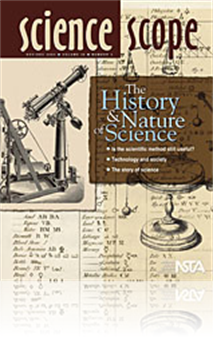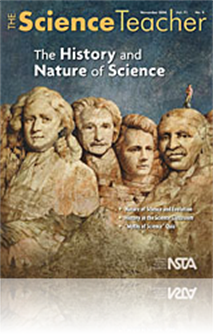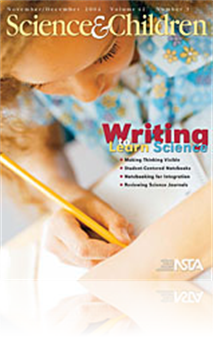All Resources
Journal Article
Astrobiology refers to the “origin, evolution, and distribution of life in the universe.” Astrobiologists study extreme environments on Earth and characterize the life forms that occupy them. These environments provide Earthly analogues to enviro...
Journal Article
Science Sampler: Birds make learning easy
The Classroom Feeder Watch (CFW) curriculum published by the Cornell Laboratory of Ornithology can be the basis for an engaging classroom unit. Through this middle school curriculum, students observe bird feeders outside their classrooms, learn to id...
Journal Article
Quizzing Students on the Myths of Science
One way to promote better understanding of the nature of science is to study myths of science by teaching, testing, and reflecting on these ideas at many points during instruction. The authors have developed a “Myths of Science” quiz for students...
Journal Article
Career of the Month: An interview with bomb investigator Barney T. Villa
When there is a bomb threat, these men and women com to the rescue. You may have seen them portrayed in movies and cop shows, but bomb technicians and investigators actually live the drama you only watch on TV. And behind the scenes, scientific tec...
Journal Article
This article provides an overview of a professional development program designed by seven science resource teachers in which science notebooks were introduced as a means of supporting and enhancing instruction across the curriculum....
Journal Article
To recognize the benefit of science notebooks, they should be viewed as useful, personalized tools rather than an assignment. This article examines how the teacher can offer support while still ensuring that the notebook is personal to each student....
Journal Article
What Belongs in Your 15-Bean Soup?
Students can use seed characteristics to discriminate between the different kinds of legumes using taxonomic classification processes of sorting and ranking, followed by construction of taxonomic keys. In this learning cycle, students participate in ...
Journal Article
Science Sampler: The scientific method -- Is it still useful?
Many scientists and science educators contend that a structured scientific method does not exist, while others might argue that the scientific method is too simplistic in its approach to scientific inquiry. This article addresses the dilemmas surroun...
Journal Article
Constructivist teaching techniques work well in various instructional settings, but many teachers remain skeptical because there is a lack of quantitative data supporting this model. This study compared an undergraduate nonmajors biology lab section ...
Journal Article
Scope on Safety: Chemicals: What's In? What's Out?
Chemistry should be fun and exciting, but much preparation and skill are needed by the teacher and students in working with chemicals. Unfortunately, accidents do happen and things can blow up, but you can help prevent these incidents by knowing and ...
Journal Article
This article describes a series of assignments that models the process of writing a manuscript for publication. While completing the assignments, students worked to improve their writing as they graphed, interpreted, and explained patterns in data fr...
Journal Article
Teaching Through Trade Books: A Season to Inquire
Aside from learning about naturally occurring cycles that happen over time, trade books about seasons can help students learn about the cause of the seasons. The activities based on this month’s books deepen students' conceptual understanding of se...
Journal Article
Technology and Society: Their Impact on Each Other
As part of the National Science Foundation–funded Internships in Public Science Education (IPSE) program, the authors created a classroom activity that encourages middle school students to think about the interactions between technology, individual...
Journal Article
The Case Study: Racism and All Sorts of Politically Correct <em> isms </em> in Case Studies
Case studies typically do not promulgate a particular viewpoint about a subject. They may, however, take a particular stance on an issue—one the author does not necessarily personally support or believe in—to challenge students to examine a diffi...
Journal Article
Science 101: What Is Acid Rain?
Acid rain is the collective term for any type of acidified precipitation: rain, snow, sleet, and hail, as well as the presence of acidifying gases, particules, cloud water, and fog in the atmosphere. This section gives a brief description of the sci...
Journal Article
In many schools, students who fail all of their classes are passed to the next grade if the students’ parents or guardians want them to be passed. The justification for this policy is that failing a student would hurt the students’ feelings and d...
Journal Article
Methods and Strategies: The 6-E Learning Model
Most teachers are familiar with the 5-E model of science instruction—Engage, Explore, Explain, Expand, and Evaluate. This model adds a sixth "E" to the tool: "e-search." E-search encompasses any use of electronic media that provides students the op...
Journal Article
A newly appointed joint hire in the College of Arts and Sciences, Department of Natural Sciences and the College of Education, Department of Middle/Secondary Education, was charged with the responsibility of bridging the communication gap between the...
Journal Article
Teaching the Stories of Scientists and their Discoveries
It takes very little extra time and effort to correlate required science concepts with history. For example, teachers can provide the historical background for Mendeleev’s development of the periodic table as students learn the concept of periodici...






